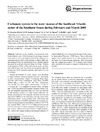Please use this identifier to cite or link to this item:
https://accedacris.ulpgc.es/handle/10553/6216
| Title: | Carbonate system in the water masses of the Southeast Atlantic sector of the Southern Ocean during February and March 2008 | Authors: | González-Dávila, M. Santana-Casiano, J. M. Fine, R. A. Happell, Jim Delille, B. Speich, S. |
Keywords: | Antarctic Circumpolar Current Weddell Gyre Interannual Variability Atmospheric Co2 Canary-Islands, et al |
Issue Date: | 2011 | Project: | Biogeoquimica Del Oceano Sur: Bonus Goodhope | Journal: | Biogeosciences | Abstract: | Carbonate system variables were measured in the South Atlantic sector of the Southern Ocean along a transect from South Africa to the southern limit of the Antarctic Circumpolar Current (ACC) from February to March 2008. Eddies detached from the retroflection of the Agulhas Current increased the gradients observed along the fronts. Minima in the fugacity of CO2, fCO2, and maxima in pH on either side of the frontal zone were observed, noting that within the frontal zone fCO2 reached maximum values and pH was at a minimum. Vertical distributions of water masses were described by their carbonate system properties and their relationship to CFC concentrations. Upper Circumpolar Deep Water (UCDW) and Lower Circumpolar Deep Water (LCDW) offered pHT,25 values of 7.56 and 7.61, respectively. The UCDW also had higher concentrations of CFC-12 (>0.2 pmol kg−1) as compared to deeper waters, revealing that UCDW was mixed with recently ventilated waters. Calcite and aragonite saturation states (Ω) were also affected by the presence of these two water masses with high carbonate concentrations. The aragonite saturation horizon was observed at 1000 m in the subtropical area and north of the Subantarctic Front. At the position of the Polar Front, and under the influence of UCDW and LCDW, the aragonite saturation horizon deepened from 800 m to 1500 m at 50.37° S, and reached 700 m south of 57.5° S. High latitudes proved to be the most sensitive areas to predicted anthropogenic carbon increase. Buffer coefficients related to changes in [CO2], [H+] and Ω with changes in dissolved inorganic carbon (CT) and total alkalinity (AT) offered minima values in the Antarctic Intermediate Water and UCDW layers. These coefficients suggest that a small increase in CT will sharply decrease the status of pH and carbonate saturation. Here we present data that suggest that south of 55° S, surface water will be under-saturated with respect to aragonite within the next few decades. | URI: | https://accedacris.ulpgc.es/handle/10553/6216 | ISSN: | 1726-4170 | DOI: | 10.5194/bg-8-1401-2011 | Source: | Biogeosciences [ISSN 1726-4170], v. 8 (5), p. 1401-1413 | Rights: | by-nc-nd |
| Appears in Collections: | Artículos |
SCOPUSTM
Citations
16
checked on Jun 8, 2025
WEB OF SCIENCETM
Citations
17
checked on Jun 8, 2025
Page view(s)
193
checked on May 17, 2025
Download(s)
202
checked on May 17, 2025
Google ScholarTM
Check
Altmetric
Share
Export metadata
Items in accedaCRIS are protected by copyright, with all rights reserved, unless otherwise indicated.
